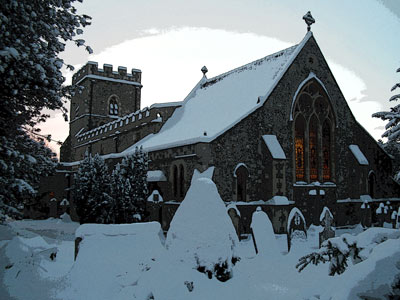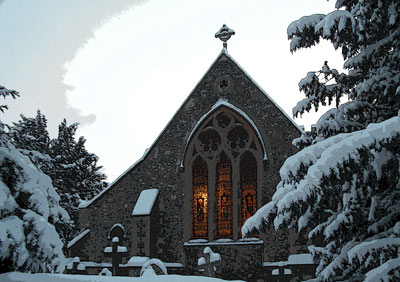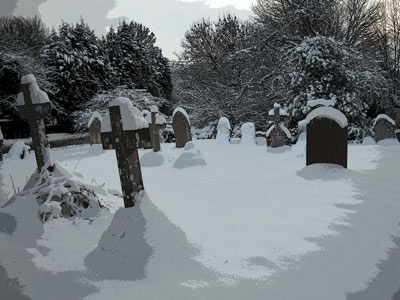I braved the elements yesterday and went to the Service of Nine Lessons and Carols at our local church, which looked rather spectacular in the snow. I took some rather lovely photos just as the light was fading, which I’ve reproduced here.

For ‘The Angel’ it’s always been my intention that something happens in the village around Christmas which symbolises Kim’s surprisingly seamless integration into the community. Â And in the sort of place where ‘The Angel’ will be set then it’s a fair bet that some sort of church carol service or similar might be a good candidate event.
Thinking about this led me on to a variation on my annual musing on the completely bizarre words that we sing to many of the most popular Christmas carols. It’s peculiar that British children sing such arcane and, in some instances, nonsensical lines but at least we all grow up with their familiarity. I wondered what a foreigner who’s otherwise fluent in English would make of the carol service hymn sheet.

Possibly the worst offender of the lot is ‘Hark the Herald Angels Sing’ — the title of which is normally misinterpreted because the hark is an exclamation, grammatically separated from the rest of the sentence. The tune, adapted from Mendelssohn is fantastically stirring but it wasn’t the original melody that Charles Wesley wrote his words for in the 18th century. Surely even then this quatrain from the second verse sounded odd:
Veiled in flesh the Godhead see;
Hail the incarnate Deity,
Pleased as man with man to dwell;
Jesus, our Emmanuel.
‘Veiled in flesh the Godhead see’ — apart from the butcherly imagery it’s a really clumsy inversion to get the rhyme with deity.
‘Adeste Fideles’ has apparently existed in Latin since the 13th century but the translation we sing as ‘O Come All Ye Faithful’ is mid-Victorian. This has a couple of great verses ‘Sing, choirs of angels, sing in exultation,’ for example, but the second verse is pretty lame:
God of God,
Light of Light,
Lo, he abhors not the Virgin’s womb;
Very God,
Begotten, not created
The third line is particularly eccentric — ‘he abhors not the Virgin’s womb’. What on earth is that meant to mean? And the fourth line seems to have thrown in the towel with a three syllable line requiring elongating to five syllables to fit the melody.

Almost certainly the most popular church services these days are the Christmas Eve midnight masses which are conveniently timed to siphon people out of the pub and into the pews. (They’re about the only times when churches are full so maybe the clergy are missing a trick the rest of the year?)
It seems some carols have been specifically written to be sung by ranks of pissed people — ‘God Rest Ye Merry Gentlemen’ is an exhortation to go to bed drunk, of which I entirely approve. Even so the line ‘This holy tide of Christmas all others doth deface’ should puzzle even the inebriated.
A couple of carols seems to have taken this principle further and have been written by people who are pissed. There can’t be any other explanation for the second verse of ‘Ding Dong Merrily On High’.
E’en so here below, below,
Let steeple bells be swungen,
And “Io, io, io!”
By priest and people sungen.
The rhyming of swungen and sungen must be unique in the English language and, perhaps, the quotation of ‘io io io’ is either an intriguing example of self-reflexiveness or simply that Charles Ratcliffe Woodward, the Victorian composer who wrote the words, had simply given up (the tune is several hundred years old). This carol is infamous for the long, extended ‘Gloria’ in the chorus, during which the amount of wavering in the singing voice  is a sure indicator of whom in the congregation on Christmas Eve is the most pissed.
As with most great pop songs, it’s the melodies that make Christmas carols enduringly popular, not the peculiar words. Many hymns also have incredibly rich and resonant tunes that have been embedded deep in the collective consciousness — something for which we have early 20th century composers such as Vaughan Williams and Holst to thank (amongst others) due to their work collecting folk music. In fact, I’d argue that carols and hymns have been one of the main influences on British popular music — the likes of the Beatles will have had the sort of education where these melodies were drilled into them. Another influence was soul music which itself adapted the melodies of these hymns sung in the American south.
One of the universally best-known melodies of all is ‘While Shepherds Watched Their Flocks By Night’ — another very ancient tune. The current words can be forgiven for being somewhat archaic as they were written around the start of the eighteenth century by the then poet laureate, Nahum Tate. It’s interesting that otherwise obsolete words, such as ‘swaddling bands’ or in ‘thus spake the seraph’ are still familiar to most people in the country.  The carol ends with one of my favourite quatrains — evoking an incredible angelic  certainty about the Christmas message:
All glory be to God on high,
And to the earth be peace.
Goodwill henceforth from heaven to men,
Begin and never cease.

Hi Mike
Scenes like those in your photos also here in Walthamstow Village at the wekend. Out and about in London was hushed and almost traffic free. Good luck with your novel(s) …I am Suffolk then Buenos Aires bound. I am about to start on my begining to end rewrite and am hopeful that this will be completed by the time I return to London at the end of March 2011.
Do you listen to The Archers – I just thought The Angel – atleast the village bit – had a similar feel…(I mean this in a complimentary way!)
Seasons Greetings Mike!
regards
Bren Gosling
Yes. I am a confirmed Archers fan. I used to listen religiously to the omnibus although I got out of the habit somehow in the summer and I’ve not got back into it recently.
There are plenty of similarities between The Archers and the setting of my novel — The Angel shares a lot in common with what I imagine the Bull to be like. However, the pub is an area where I’m not stuck for inspiration — in my mind its physical layout and appearance are a synthesis of probably a dozen different pubs in and close to the Chilterns. I’m something of a pub authority in this area — sitting at home I have the entry forms for the selection of 30 pubs from around 300 locally to go into the 2012 Good Beer Guide (such is the publishing schedule: it’s not even 2011 yet!).
Apart from The Archers there’s probably many other influences. The Vicar of Dibley is filmed within 15 miles of where the novel is set — in a lovely village called Turville whose pub, The Bull and Butcher, is currently one of our Beer Guide pubs. Also the area is dead centre in Midsomer Murders territory and many of the pubs I have in my head as influences on The Angel have been used by Inspector Barnaby and co (Lions of Bledlow, Plough at Cadsden, Royal Standard of England in Forty Green, Crown at Cuddington, Eight Bells in Long Crendon, to name but a few!).
I’m hoping to write the Christmas chapters of The Angel during the genuine festive season — my Christmas carol musings above will provide food for thought.
How marvellous to escape all the winter gloom by spending three months in Buenos Aires. I hope it’s conducive to writing. Will you still be blogging from there.
Many seasons greetings to you too.
Mike
yeah – I will Mike…do follow my progress, as I shall yours. Emma suggested I have a few weeks off and start the re write when I arrive in Argentina. To be honest my day job’s been manic these past few weeks anyway. I hope to perhaps do some new writing over Christmas whilst H and I are in SUffolk. Its freezing cold up here with the iciest of winds comming off the North Sea – it takes me back 30 years when I crewed on a trawler that departed Aberdeen in November for a month – oh, the folly of youth!
BG
Just in case you’re interested, because there is a reason for the odd turn of phrase…. “He abhors not the Virgin’s womb” would have been immediately recognizable, until perhaps the 1950s, as a quote from the 4th century Te Deum (put into English and used regularly in the BCP). Original Latin: “non horruisti Virginis uterum.”
Beth, how fascinating. I guess that line is so unusual to contemporary sensibilities (I sang the hymn again today with the once-a-year fourth verse) that there was a good reason why it was included in the first place.
I wonder if many of the poetic inversions that are found in many carols and hymns are also due to fairly literal quotations from Latin — e.g. ‘veiled in flesh the Godhead see’ or ‘and in a manger laid’.
I know that if anyone in a modern poetry creative writing course or workshop uses an inversion like that to achieve a rhyme that they tend to be immediately pounced upon and accused of being archaic.
Thanks for the comment.